Openwork crochet patterns, the patterns for creating which are presented below, are very popular among those who like to knit original and unique things for themselves and loved ones. They are knitted easily and quickly and are within the power of even novice craftswomen.
Openwork pattern "Rhombuses" crochet
The “diamond” pattern is easy to remember and looks impressive on any items – stoles, summer blouses and dresses, napkins or curtains.
Knitting pattern
To make the pattern shown in the diagram, it is enough to know how to knit the simplest loops. In the step-by-step instructions, they are conventionally designated: VP - air loops, CCH - double crochet.
Step by step knitting instructions
Cast on 39 VP.
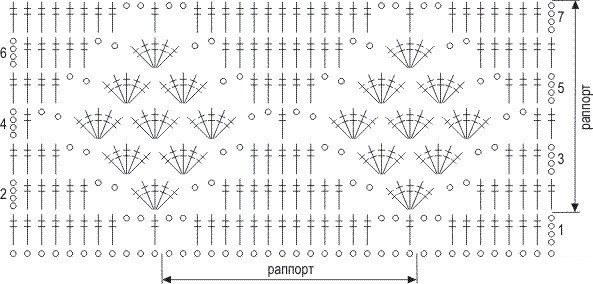
Execution of the pattern:
- First row – make 3 VP, and after 7 dc, again 2 VP, skipping 2 VP of the base – first 1 dc, 2 VP and another 13 dc. Finish by alternating 2 VP, 1 dc, 2 VP, 8 dc. Throughout the row, when making 2 VP, skip 2 VP of the base.
- A new element appears in the second row – a fan. It is 5 dc, connected in 1 loop. Sequentially perform: 5 dc, 2 ch, fan in dc located between the arches, 2 ch, 9 dc. Finish with 2 ch, fan, 2 ch, 6 dc. The last dc is always performed in the lifting loop.
- In the third row, the number of fans increases to 4: 3 DC, 2 fans of 5 DC knit from 2 sides of the bottom one into the adjacent air loops, make 2 VP, and also 5 DC. Repeat 2 VP, 2 fans and 2 VP. Finish with 4 DC.
- In the fourth row, the widest part of the rhombus is knitted – it already includes 3 fans. To begin, make 1 CCH and 2 VP. Then make 3 fans: the first – in the second loop of the arch, the second – in the fifth loop of this fan, the third – in the first loop of the second arch. Next – after alternating 2 VP, 1 CCH and 2 VP, knit 3 fans of 5 CCH again in the same way and finish with 2 VP, 2 CCH.
- The remaining rows are knitted in mirror image: the fifth row is similar to the third; the sixth is similar to the second; the seventh is similar to the first.
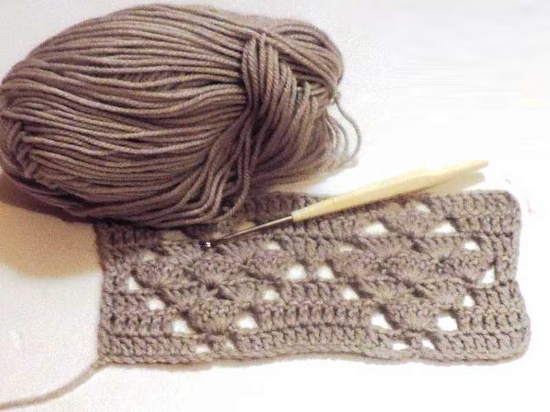
When repeating the pattern, knitting should be continued from the second row according to the diagram.
Features and nuances
Openwork crochet patterns, the patterns for which contain diamonds, are universal.
Depending on the purpose of the product, different materials are used for knitting:
- for a warm shawl, wool yarn is suitable - mohair, angora, cashmere;
- for summer blouses you can choose cotton or linen yarn, viscose, silk;
- For napkins, tablecloths, curtains it is best to use thin threads made of cotton or linen.
In order for the product to hold its shape well, the yarn must contain at least 70% natural fiber, and only polyamide threads as synthetic additives.
The choice of hook is determined by the thickness of the yarn.
Openwork pattern "rings" crochet
Although the "ring" pattern is considered complex, to knit it, it is enough to know the basic techniques of crocheting.
Knitting pattern
From the standard symbols on the diagram, SC – single crochets, SS – connecting columns are added. The ring pattern consists of 2 fragments formed by semicircles, each of them is knitted in a separate row.
Step by step knitting instructions
The rapport is 12 loops horizontally and 4 rows vertically. To transition between rows, in addition to the main pattern, 5 VP are collected from one edge of the fabric and 2 VP from the other.
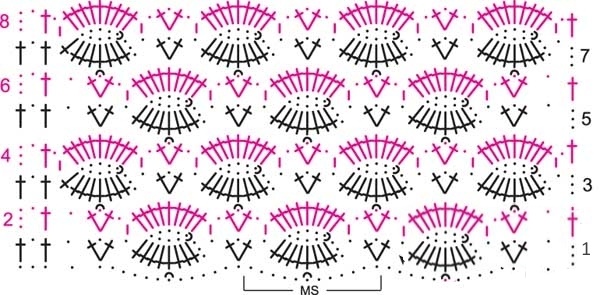
In the diagram, the set chain consists of 31 VP, and new rows begin with 3 VP and a transition VP.
Execution of the pattern:
- In the first row, knit the semicircles of the rings. They are separated by "slingshots" consisting of 2 dc and 1 ch between the columns. The sequence of execution: after lifting and 1 ch of the transition, knit the slingshot, 1 ch, make 9 more ch and close them into a ring with 1 ss. The semicircles are formed from dc: make 3 ch, turn the ring over, knit 4 dc into it. To attach the ring to the base, you need to turn it over and knit a connecting post into the sixth air loop, starting from the slingshot. Turn the ring again and knit 4 more dc into it. Make 1 ch, turn the ring, step back 5 ch, and in the sixth - knit the slingshot, 1 ch, make the next semicircle and slingshot. In conclusion - make 1 ch and 1 dc twice.
- In the second: alternate 1 VP, 1 dc, 1 VP, slingshot, 1 VP, 1 sc, 9 dc into a ring. To neatly close the circle, you need to knit 1 sc into the lifting loop for the ring. Continuation: 1 VP, slingshot, 1 VP, close the next semicircle. Finish by alternating 1 dc, 1 VP, 1 dc.
- In the third row, the first halves of the pattern are knitted again, but the rings are shifted and arranged in a checkerboard pattern. In the process of knitting, the fragment will have to be unfolded several times. Therefore, it is necessary to strictly follow the instructions. Even a small mistake will distort the pattern. At the beginning of the row, after 4 VP for lifting, there is a chain for the ring of 9 VP. It is closed with a slip stitch. Next - 3 VP, 4 CCH, sl. st. in the air loop of the lower slingshot, 4 CCH, 1 VP. The next slingshot is knitted into the top of the ring of the previous row. The remaining semicircles are knitted in the same way. Finish with 1 CCH, 1 VP, 1 CCH.
- In the fourth, the second halves of the rings are knitted and the semicircles of the third row are closed into a ring, as in the second row.

The pattern is repeated every 4 rows, not counting the initial chain.
Features and nuances
- The "ring" pattern is used for knitting blankets, stoles or as an original element of clothing or interior. For a warm blanket with a "ring" motif, it is better to choose semi-wool.
- A little fluff on the yarn will hide random mistakes in the work and will give the product additional softness, but will smooth out the pattern. To get clear lines of openwork, you need to take thin smooth yarn.
- The fabric will be smoother and neater if you use a hook twice as thick as the knitting thread.
Openwork pattern "hearts" crochet
Openwork crochet patterns, the patterns for which allow you to create a variety of designs, are “hearts”.
Knitting pattern
The diagram shows the basic loops for creating the pattern - VP, SC, DC, fan - 3 DC from one loop.
Step by step knitting instructions
The pattern is knitted around a ring formed by a chain of 8 VP.
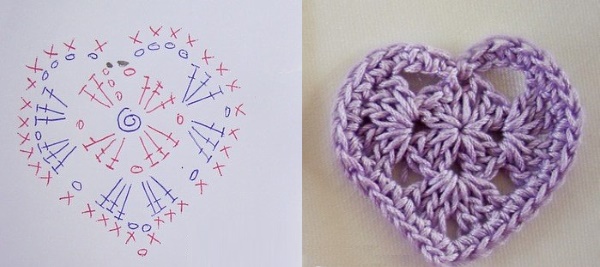
Execution of the pattern:
- In the first row, 4 fans are obtained from every second loop of the base. 3 VP, intended for lifting, are read as 1 dc. For free placement of the pattern between the fans, leave 1 VP. Finish 1 dc in the lifting loop.
- The second row consists of 6 fans, which are knitted in pairs in the first, second and third VP. The first and third pairs of fans are separated by 1 VP, and the second - 2 VP. At the beginning and end of the row - 4 VP, finish 1 SS.
- In the third row, the pattern is tied with sc: 16 sc, 1 ch, 16 sc.
Features and nuances
Openwork crochet hearts can be used to create:
- miniature napkins;
- pendants;
- applications for pillows;
- valentines;
- as coasters for cups when setting the table;
- as a basic pattern when knitting children's clothes.
Experienced craftswomen knit openwork napkins with thin cotton threads and hook No. 0.5-1. But beginners should choose thicker yarn like "Iris" and knit with hook No. 1.5.
Openwork pattern "braids" crochet
Not everyone knows that the "braid" pattern can be made not only with knitting needles, but also with a crochet hook. This relief pattern is one of the most expressive and beautiful.
Knitting pattern
The diagram consists of regular loops, so all the symbols are clear.
Step by step knitting instructions
Rapport - 8 loops. At the edges of the fabric for the transition, 3 loops are added. 30 loops are collected in the initial chain.
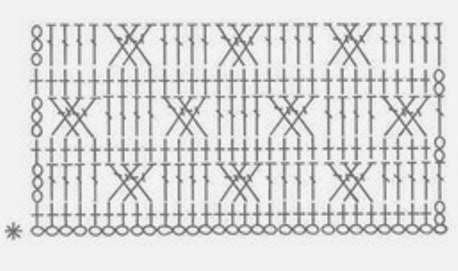 Execution of the pattern:
Execution of the pattern:
- First row – knit a set chain with single crochet stitches.
- Second: 3 VP, 4 DC, braid pattern, repeat 2 more times and close with 5 DC.
- To make a “braid”: after 4 dc, skip 2 loops and knit 1 dc into the next 2. Then return to the skipped loops and knit 1 dc twice.
- Third row: 2 VP and SC.
- In the fourth row, the “braids” are shifted and knitted over the DC of the second row.
- The fifth and sixth rows are knitted similarly to the first and second.
Features and nuances
The "braid" pattern is usually chosen for warm clothes:
- outerwear items;
- jumpers;
- winter skirts;
- scarves and hats.
The relief pattern looks especially impressive on a smooth canvas. The "braids" can be made in different widths, placed on the canvas in any direction and alternated with other patterns.
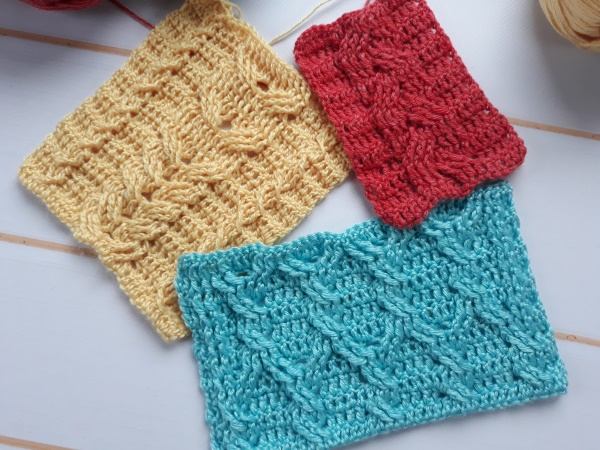
It is better to choose smooth yarn, of medium thickness and without excessive fluffiness. Its composition can be any, but it is not recommended to use a thread in several folds. Slipping off the hook, it will cause inconvenience when knitting.
Openwork pattern "paths" crochet
Openwork crochet patterns "paths" look attractive on any product, and their patterns are easy to make.
Knitting pattern
The work uses columns with 2 yarns. They are designated as СС2Н and are knitted like regular ССН, but 2 yarns are made on the hook, they are successively pulled through the loop.
Step by step knitting instructions
The diagram shows that the "path" is formed by fans of 5 dc, staggered. The fans are separated by arches of 5 dc. This pattern is created very quickly. The set chain is formed by 25 VP. For lifting in odd rows, 1 VP is used, in even rows - 4.
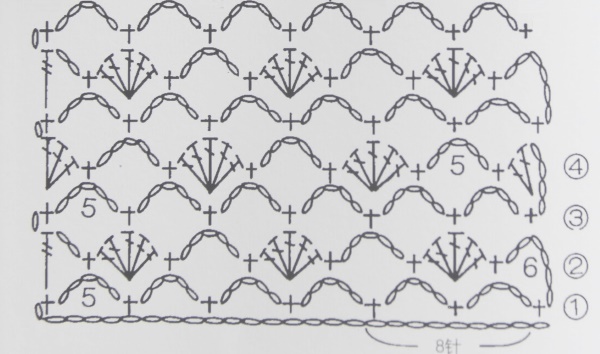
Execution of the pattern:
- In the first row: 1 sc, 5 ch, skip 3 loops, and in the fourth - 1 sc. Apply the specified algorithm to the entire row and close 1 sc.
- Second: 2 VP transition, 1 SC, made in the arch, fan in SC, 1 SC. There should be 3 fans in total. Finish with 1 SC, 2 VP, 1 CC2N.
- Third: 1 sc is knitted into dc2c. Next, arches are knitted, which are connected to fans using sc.
- The fourth row has 2 fans, staggered relative to the lower three. They are separated by arches and SC. The row begins and ends with SC.
The following rows are knitted in a similar manner.
Features and nuances
The "path" pattern is universal. It can be knitted from any yarn and used:
- as a basic pattern when knitting stoles and blankets;
- as a decorative element on pullovers and blouses;
- for finishing the bottom of a skirt or dress;
- on napkins and curtains.
When knitting "paths", you can take a hook slightly larger than recommended for the yarn. Then the fabric will be softer and looser.
Openwork pattern "vertical paths" crochet
Vertical openwork paths are very popular, as they are based on simple knitting methods., which allow you to get a huge variety of patterns. In addition, they visually lengthen the silhouette, so they are often used in the manufacture of clothing.
Knitting pattern
Step by step knitting instructions
The horizontal rapport is 13 loops, vertical – 3 rows. Two “paths” are visible on the fabric. One is formed by groups of double crochets, which are located one above the other.
The other is formed by alternating arches of VP and SSN, which are also located one above the other. The signs indicated in the diagram correspond to standard designations. Lifting loops - 3 VP.

Cast on 53 VP.
Execution of the pattern:
- In the first row there are 4 fragments, each consisting of 3 CCH, an arch of 10 VP, 3 CCH. Under the arches there is a skip of 7 loops, and their middles are connected to the base with 1 SC. For closing - 1 CCH.
- In the second: the arches between the dcs consist of 3 parts: 2 ch, 5 ch and 2 ch. They are connected to the lower arches with the help of sc. The last double crochet closes the row.
- In the third, the shape of the arch changes. It is formed by 7 CCHs, knitted into the center of the lower arch. To the right and left of it - 2 VP.
The following rows are knitted in a similar manner.
Features and nuances
- Openwork crochet patterns, the patterns of which depict various "vertical paths", give the opportunity to practice knitting techniques. They can be knitted in the form of diamonds, braids or other original patterns.
- To make a track according to the presented scheme, you can use cotton threads, using hook No. 2-2.5. The track stands out best on a canvas made of yarn in pastel colors. And the edges of the product can be tied with threads of a contrasting color.
Openwork pattern "waves" crochet
The "wave" pattern always looks unusual. But it looks especially bright when combining yarn of different colors.
Knitting pattern
A new element appears on the diagram – a “slingshot”. It is formed from 2 CCHs tied to one point.
Step by step knitting instructions
Rapport – 17 loops horizontally and 2 rows vertically. Initial chain – 34 VP. For lifting, 1 VP is used in odd rows and 2 VP in even rows.
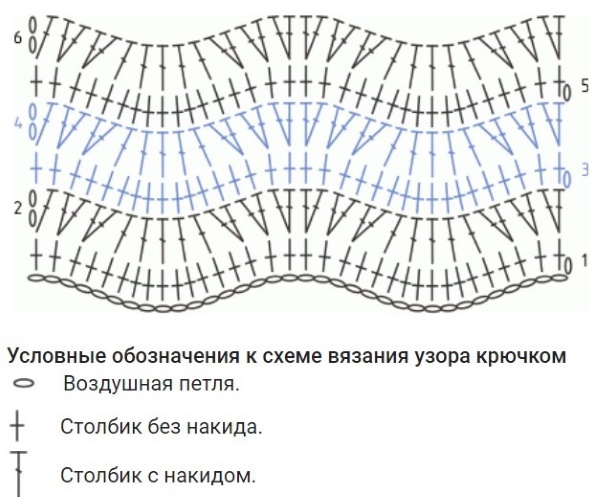
Execution of the pattern:
- The first row consists entirely of DCs - there should be 34 of them in total.
- The second one consists of 2 fragments, each of them includes 3 slingshots, 5 CCH, 3 slingshots. When performing an element of 5 CCH, it is necessary to skip a loop before, after and between them.
- The third row is knitted similarly to the first, the fourth - similar to the second.
Features and nuances
The openwork pattern "waves" gives the product additional elasticity. In different variations, often in multi-colored design, it is used when knitting children's clothes, shawls, skirts and tops. This pattern does not require restrictions in the composition of the yarn.
Depending on the functionality of the product, any one will do:
- cotton;
- wool;
- silk;
- synthetics - acrylic or polyamide;
- viscose;
- mixed fibers.
However, it is not recommended to use threads with fluff - the clarity of the pattern lines will be smoothed out, and the item will lose its attractiveness.
Openwork pattern "mesh" crochet
A simple "mesh" with an oblique arrangement of cells is made by alternating VP and SC. Using this basis, you can create different patterns in the form of "honeycombs", "scales", a simple fillet mesh.
Knitting pattern
The diagram shows a simple oblique mesh, in which the arches consist of 7 VP. The new element in the diagram is a column with 3 yarns, abbreviated СС3Н.
Step by step knitting instructions
Cast on a chain of 21 air loops. Their number is a multiple of 5, plus an additional loop for symmetry. For lifting, 4 VP are used, which are equivalent to 1 CCH3N.

Execution of the pattern:
- In the first row, the arches are connected to the base using a sc with 4 skipped loops. The pattern is repeated 4 times, closing with 1 sc.
- In the second, the single crochets are staggered, connecting the upper arches to the lower ones. To finish, 3 VP and 1 CCH3N.
- Then the pattern is repeated.
For a denser knit, the number of loops in the chains can be reduced, for example, to 5, and the gaps to 3.
Features and nuances
The choice of yarn depends on the type of openwork:
- For napkins knitted with a simple oblique mesh, it is advisable to take a medium-thickness thread that will not stretch. An excellent option would be cotton yarn with an admixture of polyamide fibers.
- For filet knitting, it is recommended to use flax or cotton. Using thicker yarn will distort the pattern. The hook should be half a size smaller than when knitting in other ways.
Openwork crochet pattern "whirlwind"
Openwork crochet patterns, the patterns of which seem complicated at first glance, are knitted from simple loops. The “whirlwind” motif is one of them. It looks original, giving things a special expressiveness.
Knitting pattern
The diagram shows that the pattern is knitted in a circle using the main types of loops - alternating VP and SC and includes 6 identical fragments.
Step by step knitting instructions
The initial chain contains 6 VPs, closed in a ring.
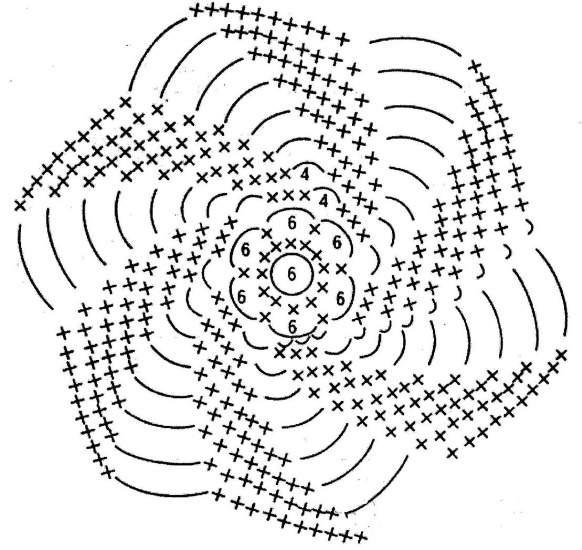
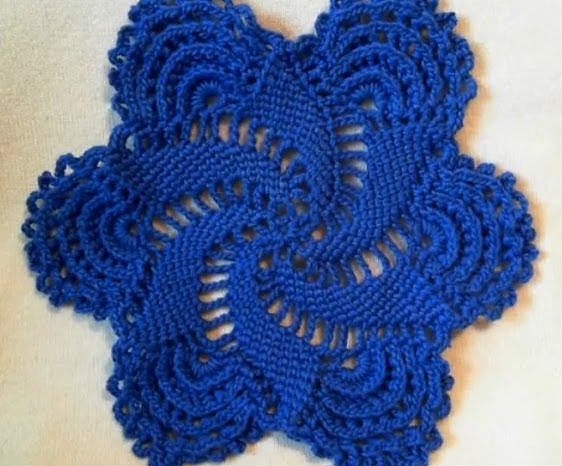
Execution of the pattern:
- In the first row, the ring immediately expands 2 times – up to 12 sc.
- In the second: arches of 6 VP are added. They are connected to every second point of the previous row using SC.
- In the third, the arches are reduced to 4 VP and then remain unchanged. The number of SC increases to 3.
- Starting from the fourth row, the number of sc in all fragments increases by 1 sc, due to which the pattern gradually expands. When connecting them to arches, skip the first sc and knit into the second and third, and the remaining 2 dc - into the arch.
- In the fifth, the fragments contain 5 sc. Of these, 3 sc are knitted into the tops of the 3 sc of the bottom row, skipping the first sc, and the remaining 2 sc into the arch.
- The following rows are knitted similarly to the fourth and fifth. Gradually the pattern expands and shifts, as the number of sc in all 6 fragments increases by 1 sc with each row. When connecting to the previous row, you need to follow the rule: skip 1 sc, and knit 2 sc in the arch. The rows are closed with connecting posts.
Features and nuances
An openwork napkin with a swirl pattern is knitted from thin cotton yarn. Particularly elegant products are obtained from spool threads No. 10. All lines of the pattern are clearly visible on the smooth fabric.
In addition, such napkins can be boiled and starched. For such a thread, hooks of size 1.0 are suitable. But for beginner needlewomen it is more convenient to use yarn such as iris or phlox and hooks No. 1.25-1.5.
Openwork pattern "butterfly" crochet
The openwork butterfly pattern looks equally good on any product:
- napkins;
- stoles;
- children's things;
- blankets.
The drawing is easy to execute, making it accessible to beginners.
Knitting pattern
All symbols on the diagram are known and understandable.
Step by step knitting instructions
Rapport – 10 loops. The “butterfly” pattern is located on the fabric in a checkerboard pattern. The initial chain consists of 31 VP. For lifting in the first row, 2 VP are used, in the rest - 1 VP.
Sequence of execution of the pattern:
- In the first row there are 3 “butterflies”. Each consists of 4 VP, 1 SC, 7 VP, 1 SC, 7 VP, 1 SC, 7 VP, 1 SC, 4 VP. Knit the entire fragment into one point of the base. Between the fragments there is 1 DC and 9 skip loops. Close 1 DC.
- In the second, connect the VP arches to the bottom row using SC. Close 1 SC.
- The third one is knitted similarly to the first one, but the butterflies are staggered. At the beginning and end there is a half of a fragment, and in the center there are 2 full patterns. Close 1 CCH3N.
- In the fourth: connect the VP sequence with the butterfly fragments using SC.
Knit the following rows in the same way as these four.
Features and nuances
For the butterfly pattern, yarn of different thicknesses is suitable, depending on the purpose of the product. However, it should hold its shape, not be too soft and flowing. Therefore, it is undesirable to use wool or viscose. Linen, bamboo, cotton, and microfiber hold their shape well.
The size of the hook is determined by the thickness of the yarn and its degree of rigidity. The thread must exactly fit the hook notch by diameter.
Openwork crochet patterns, the patterns of which are infinitely varied, add elegance and lightness to products. They allow you to create unique things that demonstrate the imagination and high level of skill of their author.
Video on the topic: openwork crochet patterns
A selection of simple, beautiful, openwork crochet patterns:

Clever girl! You explain and show very well.